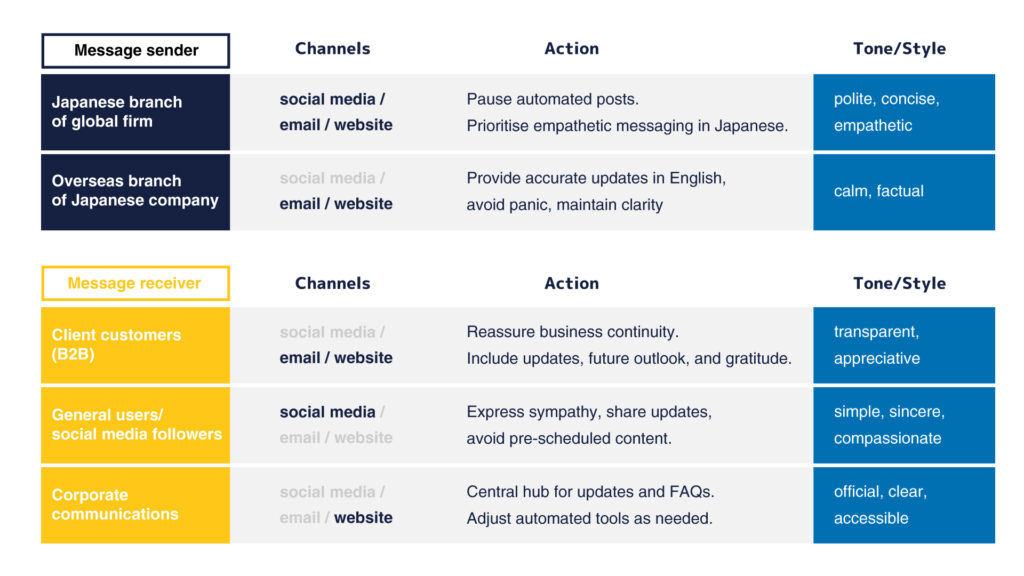Crisis Communications Guide for International Businesses in Japan

Businesses operating in Japan face the unique challenge of frequent natural disasters, from earthquakes to typhoons. Effective crisis communication during such times can preserve trust, maintain relationships, and strengthen the brand's integrity.
When these types of emergencies occur, communications teams often face several challenges:
- Risk of backlash from scheduled or automated posts
- Juggling internal safety confirmations with external messaging
- Misalignment between headquarters and local teams, often across time zones
- Pressure to communicate quickly without having complete information
Without carefully planned messaging, organisations risk alienating stakeholders, damaging reputations, or even amplifying public criticism. This article offers comprehensive guidelines to help your business deliver thoughtful, accurate, and empathetic communications during a disaster.
Why What You Say During A Disaster Matters
Japan’s cultural and geographical context places significant emphasis on how organisations respond to public crises. Disaster messaging and crisis communications impact more than immediate perceptions; they reflect the brand’s values, influence stakeholder relationships, and align with corporate social responsibility (CSR) and Environmental, Social, Governance (ESG) principles.
Empathetic and precise communication:
- Reinforces public trust in your organisation’s integrity.
- Respects cultural sensitivities and local expectations.
- Demonstrates leadership during unpredictable circumstances.
Navigating these high-stakes moments effectively starts with anchoring your approach in three essential principles.
The Three Key Principles of Crisis Communications
When crises occur, organisations must quickly determine what to communicate and how to convey their message. Adhering to the following principles ensures your messaging resonates positively.
1. Empathy
Expressing compassion for those affected is an unequivocal starting point. Acknowledge the gravity of the situation and prioritise understanding over corporate self-interest. For example:
- Begin statements with messages of support for victims and their families.
- Avoid launching immediately into updates about your company’s operations.
- Adapt the tone across the disaster’s lifecycle, ensuring continued sensitivity from incident response to recovery.
Example:
"We extend our heartfelt condolences to everyone affected by [disaster name]. Our thoughts are with those impacted, and we remain committed to supporting recovery efforts."
2. Cultural Sensitivity
Cultural expectations in Japan lean towards restraint and humility. Overly promotional or overly casual messaging can come across as disrespectful or tone-deaf. Adjust your communications to align with societal norms:
- Where appropriate, consider delaying outbound campaigns unrelated to the disaster.
- Approach casual language sparingly, opting for measured and respectful tones.
- Ensure all messaging respects the broader emotional atmosphere, especially in times of national mourning or heightened distress.
Instead of: "We’ve got amazing deals this week!"
Opt for: "Out of respect for recent events, we have postponed our campaign updates. We hope you and your loved ones are safe during this time."
3. Accuracy
Credibility suffers when information is vague or contradictory. Only share facts verified through official or reliable sources such as government agencies or meteorological bureaus. Avoid any reassurances that lack evidence or context.
- Instead of simply saying “everything is under control”, provide transparent overviews of operational disruptions or recovery efforts, clearly setting expectations instead of making generic claims.
- Ensure self-critical updates (e.g., delayed timelines) are shared in a way that prioritises transparency over defensiveness.
Example:
"We are monitoring the evolving situation closely and will update you promptly should changes impact our services."
3. Audience- and Channel-Specific Crisis Communications Guideline

Consistency across departments, especially between the global HQ and local branches, is critical. Establish clear internal roles and communication workflows to avoid confusion.
4. Tone of Voice Best Practices
Disaster- and crisis-related messages require extra care with tone and expression. Have native speakers review messaging before publishing.
In Japanese
- Use calm, respectful, and formal language (keigo)
- Avoid subjective statements or false reassurances
In English
- Keep tone clear and measured
- Refrain from overly emotional or overly positive expressions
Avoid phrases like:
- “Everything is fine” or “No need to worry” (if unverifiable)
- “Panic” or “chaos” (may heighten anxiety)
- Casual language (may appear insensitive)
5. Step-by-Step Process for Crisis Communications
- Pause all scheduled content
Stop or revise pre-planned posts and campaigns immediately, starting with high-visibility platforms like social media and email. - Assess impact on your company
Confirm employee safety, office conditions, and business disruptions. Share updates internally first. - Align with key departments
Coordinate with PR, customer service, and HQ teams to define messaging strategy and timing. - Draft messages in Japanese and English
Follow the three principles: empathy, sensitivity, accuracy. Have content reviewed by native speakers. - Publish updates across channels in priority order
Once approved, publish first on social media, then on your website, followed by email. Act quickly but carefully. - Revise messaging regularly as the situation evolves
Maintain consistency across channels. Clearly communicate changes and developments.
6. Sample Messaging Scenarios
If your company is not directly affected
Japanese:
このたびの地震で被災された皆様に、心よりお見舞い申し上げます。
弊社は通常通り業務を継続しておりますが、状況に応じて柔軟に対応してまいります。
最新の状況については、ウェブサイトで随時お知らせいたします。
English:
We would like to extend our heartfelt sympathy to those affected by the recent earthquake in Japan. Our operations remain unaffected, and we continue to provide services as usual. Should the situation change, updates will be posted on our website.
If your company is affected
Japanese:
このたびの地震で被災された皆様に、心よりお見舞い申し上げます。
現在、社員の安全確認と業務継続体制の整備を進めておりますが、一部サービスに遅延が発生する可能性がございます。
最新の状況については、ウェブサイトで随時お知らせいたします。
English:
We would like to extend our heartfelt sympathy to those affected by the recent earthquake in Japan. We are currently confirming the safety of our employees and working to maintain our operations. Some delays may occur, and we will provide updates on our website as needed.
Adjust tone and content based on your relationship with the recipient and your industry’s norms. Always verify with local teams and native speakers.
7. Resuming Normal Communications
After a major disaster, the decision to resume regular communications should be made cautiously. Begin only after your internal structure has stabilised and society is beginning to recover.
Key recommendations:
- State your reason for resuming communications
“We are gradually resuming communications following internal confirmation of employee safety and operational readiness.” - Maintain a respectful tone
Avoid language that may seem flippant or commercial.
Instead of: “Excited to launch our new campaign!”
Say: “We are resuming communications and will share updates as appropriate.” - Acknowledge those affected
Open with continued sympathy for victims and those recovering.
Reminders:
- Don’t suggest that recovery means everything is resolved.
- Communicate any limitations or disruptions honestly.
- Express gratitude for support and understanding.
8. Final Notes
Natural disasters and crises are unpredictable, and knowing how to respond can be challenging. This guide is designed to support internal alignment and help you make sound decisions under pressure.
Each decision, like what to say or how to phrase a message, can influence brand trust and long-term relationships. There is no universal formula, but we hope these principles and examples serve as a useful reference.
We encourage you to share this guide across departments, including sales, marketing, and customer service, to ensure a unified approach. It can also serve as a basis for discussion and training within your organisation.
9. How TAMLO Can Support You
TAMLO offers bilingual content marketing support with a deep understanding of Japan’s culture and language. From messaging strategy to localisation, we help companies communicate thoughtfully during crises.
Our support includes:
- Drafting English-Japanese crisis messages
- Custom templates for websites and social media
- Bridging cultural/language gaps between HQ and Japan offices
- Planning scenario-based messaging
- Phased support for resuming regular communications
If your company needs guidance on crisis communications in Japan, please feel free to contact us.




